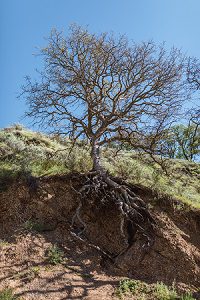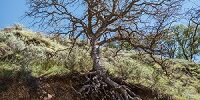Terese Abreu, MA, MLS(ASCP)CM, ASCLS Region IX Director, 2017-20
 |
| Photo by Jason Leung on Unsplash |
During my lifetime I have seen many protests, including the one that is in the book I am reading right now, regarding preservation of old growth forests. The book begins with roots, and as a biology major, I find it fascinating to consider what is happening beneath the surface, hidden from sight. It reminds me also of the documentary I saw recently, Tracing Roots, regarding Alaskan native spruce root weavers and DNA connections of a woven hat discovered in a glacier. Weaving is a deep-seated tradition that grounds and defines many Native Americans. Our roots are important to us and provide a means to see how we are connected to one another. The promise of discoveries found in the results of DNA testing fascinates those searching for their roots.
The medical school in my community, rooted in the homelands of the Yakama Nation, has developed a program called “Roots to Wings.” This program is addressing disparities in healthcare in our diverse community of Native Americans and Mexican-Americans through a co-mentoring program where medical students collaborate with youngsters in the local middle schools, in various ways, to stimulate interest in further education and possible careers in healthcare. In turn, the medical students have a chance to understand the real issues of the population they are training to serve.
In ASCLS, our roots (our members) provide great diversity, yet we struggle to fully understand the issues that each of our members face. We work in different types of healthcare facilities serving very diverse local populations, struggling to remain effective and relevant under various state requirements, geographical, cultural, and ethnic challenges.
In root basket weaving, finding, collecting, and preparing the right roots is critical to success in weaving. A strong, healthy root system supports the growth of 100-year-old trees and the life of the forest they live in through seasons of drought, floods, fire, and hurricanes. As a grassroots organization, our purpose and direction reflect the shared problems and solutions of its members.
“The roots of ASCLS, our members, bring great diversity to our organization and have allowed us to survive and be successful despite changes that some were sure would destroy us.”
So, how can ASCLS members leverage our roots more effectively and efficiently so that we can move our organization forward in this time of decreasing membership and volunteers? The ASCLS Board of Directors has come to realize the journey forward has to start somewhere. Each of us, as members of ASCLS, have responsibility for the success of our organization, and we all must be willing to do our part.
The board read three books to guide us on our journey forward. Start with Why, by Simon Sinek, led the board to consider how we could think and act together to inspire others to action in the hope that members will follow because they want to do so. To get there we had to determine our “WHY.” Why does ASCLS exist? There is great power in a common goal.
Race for Relevance by Harrison Coerver and Mary Byers helped us to see that as an organization, we simply cannot be everything to everyone; it is just too broad a focus. Our members have diverse skills, but limited time to donate, so it is not possible to do everything. It falls to the elected volunteers to determine what would bring the most value to ASCLS members and then determine which volunteers are best qualified, or possess the skill sets needed, to accomplish the work and do so quickly enough to maintain the organization.
The Will to Govern Well put out by ASAE, The Center for Association Leadership, illustrated to the board we must make decisions based on factual knowledge, rather than opinions, and that leaders must have the respect and trust of those they represent if they are to be successful. This in turn motivates and inspires volunteers to continue to lend their limited time and valuable skills for the benefit of our organization and our members. ASCLS needs to be nimble and move quickly when needed.
A perfect example of nimbleness and the power of a common goal within our organization, our membership, and our profession is on display for all during this frightening and stressful time of SARS-CoV-2. Our Joint Annual Meeting had to change, our work had to change, our schools had to change, we had to change, virtually overnight.
The roots of ASCLS, our members, bring great diversity to our organization and have allowed us to survive and be successful despite changes that some were sure would destroy us. We are passionate about our profession, our patients, and the communities we serve. Focusing on our common goal, and demonstrating trust, support, and respect for each other are critical to having the healthy roots that will lead to the growth and success of our professional organization.
Eagles are sacred to Native Americans. Eagles soar! They represent honesty, truth, majesty, courage, wisdom, power, and freedom. If we take the time to understand the real issues, and move past preconceptions, we can see that ASCLS is moving forward and doing so with increased relevance for all of us. Roots to wings.
Terese Abreu is Director of the Medical Laboratory Science Program and Assistant Professor at Heritage University in Toppenish, Washington.
